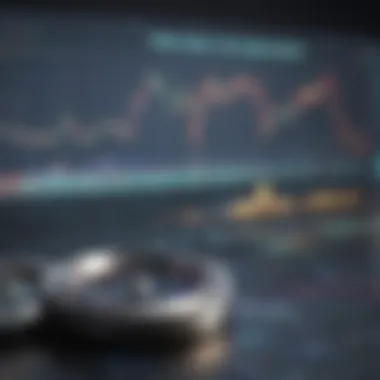Mastering VIX Trading: Strategies for Success


Intro
Understanding market volatility can be the difference between a profit and a loss in the world of trading. Among various tools available to traders, the VIX, or Volatility Index, stands out as a reliable barometer of current market conditions. Often referred to as the 'fear index,' it reflects the market's expectations of future volatility. In this section, we delve into the significance of the VIX and its applications in diverse trading strategies.
Traders and investors often grapple with the uncertainty that fluctuations in market conditions bring. The VIX encapsulates this sentiment, fluctuating based on the options market, particularly those of the S&P 500 Index. When fear dominates, the VIX tends to rise, signalling increased market instability. Conversely, a low VIX suggests a stable, calm market atmosphere.
Incorporating the VIX into trading decisions can provide traders with a strategic advantage. By deciphering its movements, one can gauge potential market shifts, identify opportunities, and manage risk more effectively. This article intends to impart knowledge on the VIX, enabling traders and investors alike to make informed decisions that could enhance their trading outcomes.
"The VIX is more than just a number; it's a reflection of market sentiment and risk appetite."
Investment Dictionaries
Understanding key financial terminology is crucial for any trader aiming to leverage the VIX in their strategies. Here, we break down essential terms related to the VIX and market volatility that every trader should know.
Key Financial Terms Explained
- Volatility: Refers to the degree of variation of a trading price series over time. A higher volatility indicates a larger price range in short periods.
- Options: Financial derivatives that give the buyer the right, but not the obligation, to buy or sell an underlying asset at a predetermined price before expiration.
- S&P 500: A stock market index that measures the stock performance of 500 large companies listed on stock exchanges in the United States.
- Implied Volatility: A measure derived from the price of options, representing the market's forecast of a likely movement in a security’s price.
- Risk Premium: The return in excess of the risk-free rate of return an investment is expected to yield; compensating investors for taking on the relatively higher risk.
Understanding Investment Jargon
Navigating financial markets demands familiarity with industry-specific jargon. Phrases like 'bull market' or 'bear market' often surface in trading discussions. Understanding these phrases is vital in assessing market trends and timing trading entries or exits accordingly.
In the fast-paced environment of trading, a clear comprehension of these terms will serve traders well. They form the foundation upon which strategic trading with the VIX can be built, aiding in informed decision-making and positioning for potential profits.
Prolusion to
The VIX, often referred to as the "fear index", serves as a barometer of market sentiment and is a pivotal element in trading strategies. Understanding this index's intricacies offers significant advantages for traders and investors alike. When it comes to navigating the complexities of financial markets, grasping how VIX operates can empower market participants to make better-informed decisions. These benefits encompass not only risk management but also opportunity spotting in volatile environments.
In this section, we will delve into the precise definition of the VIX and shine a light on its crucial role within the financial securities landscape. The objective is to provide a solid foundation on which traders can build nuanced strategies that leverage the VIX.
Definition of
The VIX is a measure of expected volatility in the S&P 500 index options market. Essentially, it reflects the market's expectations of future volatility over the next 30 days. Simply put, a higher VIX value indicates that traders anticipate significant price swings, while a lower value suggests that they expect relatively ruffled waters. As a mathematical construct, the VIX uses options prices to gauge anticipated fluctuations in the underlying stock price, translating those perspectives into a tangible index value that market participants can utilize.
The VIX itself does not predict the direction of market movement – it only indicates the level of expected volatility. For instance, if the VIX rises sharply, it's a signal that investors may be bracing for turmoil or uncertainty. Conversely, a declining VIX might indicate a period of relative calm and stability.
Importance in Financial Markets
Understanding the VIX's importance is akin to having a compass in the unpredictable seas of trading. Here's why it holds such weight in financial markets:
- Risk Assessment: Investors use VIX to gauge the risk involved in holding positions. A high VIX can trigger an assessment of risk exposure, potentially prompting traders to hedge.
- Market Sentiment Gauge: It provides a snapshot of investors' feelings. For example, in times of economic uncertainty, a spike in the VIX may correlate with a downturn in stock market performance.
- Investment Decisions: Asset managers and institutional investors often factor VIX levels into their portfolios, adjusting their strategies based on volatility predictions.
The VIX is not just a number; it encapsulates the emotional undercurrents of the market, providing a snapshot of where traders believe the market is headed.
In summary, the VIX is a vital indicator that helps traders navigate the complexities of market sentiment and volatility. By comprehending what the VIX is and why it's essential, readers can better position themselves to utilize this powerful tool within their trading strategies.
Understanding the Mechanics of
Understanding the mechanics of the VIX is crucial for traders and investors looking to navigate the complexities of the market effectively. The VIX, often dubbed the "fear gauge," serves as a barometer of market volatility. By grasping how it operates, market participants can better predict market behavior and align their strategies accordingly.
How is Calculated
The VIX is calculated using the prices of options on the S&P 500 index, which reflects the expected volatility of the index over the next 30 days. To put it plainly, if option prices suggest more uncertainty about future movements, the VIX rises; conversely, if options indicate lower uncertainty, the VIX falls. The formula used involves both call and put options prices, factoring in strike prices and their associated premiums, which makes the calculation somewhat intricate yet essential for capturing market sentiment.
This calculation process taps into the collective fear or confidence of traders. The precise quantitative methods denote that an increasing VIX value likely signals potential downside risks in the market, while descending values could indicate a more stable, or even bullish, environment. Understanding this calculation not only helps in gauging potential risk but is fundamental in making informed decisions about option trades and dealings in various financial instruments.
Components Influencing Values
Several key components influence VIX values beyond mere option prices:
- Market Conditions: Bull markets typically see lower VIX readings, while bear markets drive higher values.
- Economic Indicators: Macroeconomic data releases, such as unemployment rates or inflation figures, can sway market sentiment, causing VIX fluctuations.
- Geopolitical Events: Unexpected political developments, skirmishes, or significant policy changes can lead traders to expect increased volatility, resulting in higher VIX values.
- Market Psychology: The emotions and behaviors of traders can cause abrupt changes in VIX values—fear tends to spike volatility.
Understanding these components provides a multi-faceted insight into not just where the VIX is but why it is where it is.
Historical Trends of
Historical trends of the VIX offer a fascinating perspective on how market sentiment has evolved over time. Looking back through data reveals patterns that can aid in predicting future behavior. For instance, during periods of economic distress, such as the 2008 financial crisis or the onset of the COVID-19 pandemic, the VIX experienced spikes, surging beyond typical levels due to heightened fear and uncertainty.


Conversely, in stable economic periods, the VIX tends to hover at lower levels. This historical context can guide traders in setting expectations and making strategic decisions. Analysing these patterns allows investors to determine whether current VIX readings are within a historical norm or if they represent potential market opportunities or dangers. A trader keen on understanding the environment they are operating in should always keep a close eye on these historical trends.
Interpreting Movements
Interpreting VIX movements is crucial for traders and investors looking to understand market dynamics better. The VIX serves as a barometer of market sentiment, indicating the level of uncertainty investors feel about future market performance. By grasping how to read these fluctuations, one can gain insights not just into volatility but into potential market trends as well.
Volatility and Market Sentiment
Volatility is a fundamental concept in financial markets, as it reflects the degree of variation in trading prices. When the VIX is rising, it usually signals that investors are becoming anxious about future market downturns. This increased fear often results in a surge of put options being purchased, as traders seek to protect their portfolios. Conversely, a falling VIX indicates a period of calmness in the markets where traders may feel more confident and, therefore, more willing to take on risk.
The relationship between volatility and market sentiment can often paint a clearer picture than the prices themselves. For instance, during a turbulent period, such as the 2008 financial crisis, the VIX skyrocketed, reaching levels unseen in the past. The implications were clear: a high VIX correlates with apprehension and uncertainty among investors.
- Interpreting rising VIX values: Traders can interpret rising VIX values as a cue to reassess their risk exposure and possibly hedge against losses.
- Interpreting falling VIX values: In contrast, decreasing values suggest a more stable environment, ideal for aggressive strategies aimed at capitalizing on rising prices.
Understanding these signals can effectively guide traders in making timely and informed decisions, allowing them to take advantage of market movements rather than merely reacting to them.
High vs. Low Levels
Assessing whether the VIX is at a high or low level can help traders shape their strategies. The VIX typically ranges from single digits to the mid-thirties, with fluctuations determined by various factors impacting the market.
- High VIX Levels: A VIX above 30 is generally seen as indicative of extreme fear in the market. When this occurs, there is often more volatility in stock prices. Traders may opt for hedging strategies or protective puts during such times to mitigate risk. Importantly, while high VIX levels suggest increased risk, they can also present opportunities for profit. Well-timed investments in sectors known for recovering quickly from downturns can yield significant returns.
- Low VIX Levels: A VIX below 20 usually suggests a stable market or investor complacency. Low levels can signal a period of sustained growth or a continuing rally in equity markets. It is often when traders feel safer that markets begin to overheat, leading to increased trading volumes. In these scenarios, short-sellers often become more active as the market presents conditions ripe for pullbacks.
In the end, interpreting VIX movements requires careful attention and an understanding of the broader market context. Recognizing the significance of both high and low levels enables informed decision-making and strategic positioning—all essential for refined trading.
"The VIX isn't just a number; it's a reflection of the collective moods and thoughts among investors."
Through these lenses, traders can make sense of volatility and sentiment, turning the VIX into a powerful tool in their trading arsenal.
Trading Strategies Involving
The VIX, known for reflecting market volatility, plays a crucial role in the trading landscape. Its stochastic nature can help traders strategize effectively, turning unpredictability into opportunity. Understanding how to navigate trading strategies involving the VIX can yield advantages when the market is on shaky ground. In this section, we will explore the nuanced ways traders can leverage the VIX to hedge against downturns, speculate on potential spikes in volatility, and optimize timing for market entry and exit.
Hedging with Instruments
Hedging is like putting on a seatbelt—it’s about safeguarding yourself against unforeseen turbulence. The VIX serves as an effective hedging tool, particularly during market downturns. When equities are in a tailspin, VIX instruments like options and futures often rise in value. For instance, a trader holding a portfolio of stocks might purchase VIX call options to offset potential losses. If the market takes a nosedive, the gains from the VIX options can help cushion the blow.
However, it’s important to grasp that hedging isn’t foolproof. The VIX can be volatile itself, and without proper monitoring, the hedging strategy might backfire. Trading VIX futures can also serve as a hedge, but timing here is essential. Should the market remain stable or rally, these hedges might turn into losses. Always consider the costs and execution risks associated with these instruments, striking a balance between protection and potential profit. With this in mind, it's vital to assess your risk tolerance before diving headfirst into VIX hedging strategies.
Speculating on Volatility Changes
Speculation has its thrill, similar to a rollercoaster ride—it can be exhilarating but also fraught with risk. Trading on volatility changes through VIX options offers an avenue for assuming risk with the potential for high rewards. When volatility is low, savvy traders may purchase VIX call options, betting that there will soon be a spike. Conversely, during high-volatility environments, traders might opt to sell VIX options, anticipating a decrease in fear sentiment.
A classic example can be seen during significant geopolitical events, where uncertainty often triggers a spike in VIX. Traders alert to these signs can seize opportunities to profit from quick fluctuations in volatility. However, this requires an acute sense of timing and market awareness. Following patterns in historical volatility can provide insights that aid these speculative efforts, but the psychological aspects cannot be overlooked. Anyone who’s traded while emotions run high can attest to the risks of letting fear or greed dictate decisions.
Using for Timing Market Entry and Exit
Timing the market is the Holy Grail for many investors, with the VIX acting as a compass of sorts. A high VIX reading might indicate that fear is prevalent, suggesting it could be an opportune moment to buy stocks, as many may be selling in a panic. Conversely, a low VIX could signal complacency, signaling potential market tops that warn traders not to enter or to consider shorting.
When using the VIX for entry and exit timing, one must pay attention to patterns. For instance, traders might look for a rebound in VIX levels that correlate with rising equity prices, indicating shifting sentiments. This sort of analysis involves more than a hunch; it requires the trader to examine VIX to price relationships and understand their historical context. Also, remember that markets don’t always follow textbook behavior, so sticking strictly to rules can be detrimental. Flexibility and adaptability in the face of changing market conditions will serve you well.
As the saying goes, "Don’t put all your eggs in one basket." When utilizing VIX in trading strategies, diversifying your approach keeps risk in check and enhances potential returns.
Through the various strategies involving the VIX, traders can navigate the complexities of the market landscape. Each method offers unique tools for insight and decision-making, establishing a robust framework for managing risk while pursuing opportunity.
Risk Management with
Risk management is a cornerstone of successful trading and investing. When it comes to utilizing VIX, understanding its implications can serve as a powerful tool in a trader’s arsenal. The VIX, often referred to as the ‘fear index,’ provides insights into market volatility, which directly influences risk assessments. When traders grasp the nuances of VIX movements, they can better navigate uncertain waters and bolster their decision-making process.
Assessing Market Risk Through
To effectively use VIX for risk management, one must first comprehend the relationship between VIX values and market sentiment. A rising VIX generally signals increased volatility, often precipitated by uncertainty or fear in the market. Conversely, a decreasing VIX points toward a more stable environment.
- Higher VIX indicates:
- Lower VIX suggests:
- Market anxiety
- Potential downturns or corrections
- Investor confidence
- Steady or bullish trends
By assessing VIX levels, investors can gauge market risk more accurately. It’s essential to continuously monitor how the VIX correlates with specific stocks or sectors. Some stocks tend to react strongly to fluctuations in VIX, while others exhibit more resilience. Taking a holistic approach and analyzing these correlations helps traders place their investments on solid footing.


Adding the VIX to regular market analysis also grants a broader viewpoint. For instance, during periods of economic turmoil, an investor might see elevated VIX readings, signaling that it may be prudent to tighten positions or reassess strategies. In aligning investments with VIX data, one can either shield themselves from potential losses or exploit opportunities in volatile times.
Setting Stop-Loss Orders Relative to
Another practical application of VIX in risk management is in setting stop-loss orders. A stop-loss order acts as a safety net, designed to limit an investor’s potential loss on a trade. By incorporating VIX levels into this strategy, traders can enhance their exit plans.
When VIX levels are high, it may be wise to widen stop-loss orders. This is because high volatility can trigger price swings, potentially activating a premature exit. Conversely, in a low-VIX environment, tighter stop-loss orders can be appropriate. Here, the expectation of less drastic price movements makes it safer to execute tighter limits.
Ultimately, using VIX as a guide for setting stop-loss orders enables traders to balance risk and reward better. It acknowledges the current market conditions, providing a pragmatic framework to protect one’s capital without sacrificing too much potential profit.
"In trading, the ability to balance risk and reward is not just a strategy; it's an art form. Integrating VIX into your risk management tactics is like having a compass in uncharted waters."
Through these strategies, the VIX can help in creating a robust risk management framework that adapts to changing market dynamics. Understanding how to assess market risks and setting adequate stop-loss orders relative to VIX levels empowers investors to make smart trading choices and potentially safeguard their portfolios.
The Role of in Diversifying a Portfolio
Diversification is a cornerstone of investment theory, intended to reduce risk by not putting all your eggs in one basket. Incorporating the VIX into a portfolio can enhance this strategy, enabling traders to cushion against fluctuations in other asset classes. In times of market unrest, the VIX often behaves differently compared to stocks and bonds, making it a valuable tool for balancing a portfolio.
When market conditions turn sour, the fear index tends to rise, which often coincides with falling stock prices. This inverse relationship provides an opportunity for investors to mitigate losses through thoughtful asset allocation. For example, including VIX options or VIX-related ETFs can help offset downturns in equities, providing a protective layer.
Correlation Between and Asset Classes
Understanding the correlation between the VIX and various asset classes is vital for effective portfolio management. Generally, the VIX shows a negative correlation with equities, which means that as stock prices tumble, the VIX tends to climb. Conversely, in a bullish market, the VIX often falls, reflecting lower volatility and greater investor confidence.
> "During periods of high volatility, investors might multiply their defensive positions by incorporating VIX-linked securities."
Here are a few key correlations to note:
- Stocks: The VIX typically spikes during stock market pullbacks. This means having positions in VIX can provide downside protection.
- Bonds: The relationship varies; while treasury prices often rise in a flight to safety, the VIX may not react the same way, presenting unique dynamics.
- Commodities: Commodities like gold are often seen as safe havens, correlating differently with the VIX. Sometimes, both can rise during market chaos.
Analysts frequently monitor the VIX alongside other indices to better predict the overall market sentiment.
Incorporating into Asset Allocation
To effectively weave the VIX into your portfolio, careful asset allocation is imperative. It isn't enough to simply buy VIX securities; the key is to adjust them as market conditions evolve. Investors should consider the following:
- Proportion of Risk: Assess how much volatility you can tolerate. A well-balanced portfolio might include a small percentage of VIX instruments, acting as a hedge against standard equity holdings.
- Rebalancing Strategy: As market conditions shift, regular rebalancing to adjust VIX exposure becomes necessary. This ensures that your strategy continues to align with your risk profile and market outlook.
- Market Timing: Understanding when to increase or decrease VIX exposure can be crucial. For instance, if economic indicators suggest increasing market turbulence, consider increasing your VIX allocation to better soak up volatility.
In summary, the use of the VIX in diversification depends heavily on understanding both your risk tolerance and market sentiments. It's not just about adding another asset; it's about building a cohesive strategy that mitigates risk across various potential scenarios.
Futures and Options
Understanding VIX futures and options is fundamental for traders who seek to navigate the complexities of market volatility. As derivatives of the VIX, these financial instruments allow market participants to hedge against fluctuations, speculate on future volatility, and enhance portfolio diversification. Traders can capitalize on the movements of the VIX without having to directly trade the underlying index itself.
Understanding Derivatives
VIX futures and options represent agreements to buy or sell VIX contracts at predetermined prices on future dates. The futures contracts are standardized and traded on exchanges such as the Cboe Futures Exchange. Unlike standard equity options, VIX options provide traders with the power to potentially profit from not only an increase in implied volatility but also from volatility drops.
One key aspect to note is the relationship between VIX futures and the actual VIX index. Typically, there exists a technical disconnection; futures prices often differ significantly from the spot VIX index. This can lead to opportunities for traders who are able to spot discrepancies and make strategic moves.
For example, during market upheavals, the VIX often spikes, which can create a situation where VIX futures are priced above the expected future value of the VIX. Conversely, these contracts may trade below the VIX under more stable market conditions.
Trading Strategies with Options
Integrating VIX options into trading strategies can be quite rewarding, though it carries its share of risks. Here are some noteworthy strategies:
- Buying Call Options: When a trader anticipates a spike in market volatility, purchasing call options on the VIX allows for leveraged exposure to rising volatility while limiting downside risk.
- Selling Put Options: This strategy can be effective in stable markets. If the VIX remains low, put options can expire worthless, yielding profit from premiums received.
- Straddles and Strangles: These strategies aim to capture movement in the VIX regardless of the direction. A straddle involves buying both call and put options at the same strike price, while a strangle uses different strike prices. They can be particularly useful if significant market events are anticipated.
With VIX options, the timing is everything. Traders need to closely monitor market sentiment, news events, and economic indicators to make informed decisions. This necessitates a keen understanding of the VIX’s daily movements and its implications for market dynamics.
"Successful options trading is not just about choosing the right instrument but understanding the market forces that drive volatility."
Ultimately, VIX futures and options can be valuable components of a trading strategy, enhancing a trader's ability to respond to market changes and manage risk effectively. However, prospective traders should always consider their risk tolerance and market outlook when integrating these tools into their investment plans.
Case Studies: Successful Trading
In the realm of financial markets, how traders harness the VIX can illustrate not just strategy but the very fabric of market psychology. Case studies surrounding VIX trading offer invaluable lessons. By scrutinizing successful trades and distinguishing patterns, investors can enhance their own decision-making processes. Learning from real-world examples brings depth and perspective, making abstract concepts more tangible.
Historical Market Events and Performance


Historical events often reveal VIX’s character as the so-called ‘fear gauge.’ Significant market declines, such as the 2008 financial crisis and the early pandemic sell-off in March 2020, showcase how sharp spikes in the VIX corresponded with investor panic.
During the 2008 crisis, for instance, the VIX surged above 80—a level unprecedented at the time. Investors who recognized this spike as a potential entry point for buying undervalued assets could have capitalized on the eventual recovery. Those who had acted with careful analysis, observing VIX behavior, distinguished themselves amid chaos.
In March 2020, with sudden lockdowns and uncertainty sweeping global markets, the VIX escalated rapidly—a harbinger of volatility. Savvy traders utilized this increased volatility to hedge their portfolios effectively, while others examined the implications of a high VIX for market reversals.
Clearly, understanding VIX performance during significant downturns can inform a trader's strategy. The ability to recognize these patterns not only aids risk management but also presents opportunities for timing market entries and exits better.
Analysis of VIX-Based Trades
Diving into specific trades helps clarify the potential of VIX. One notable case is a series of options trades executed during the period leading up to the 2016 US presidential election. Traders speculated on market movements based on perceived uncertainty surrounding election outcomes. Those who bought VIX call options realized substantial gains as the VIX surged in reaction to the surprising result.
- Key Considerations for VIX trading:
- Market Sentiment: The VIX reflects overall market sentiment. High values typically indicate fear, which can create short-term trading opportunities.
- Option Strategies: Out-of-the-money calls on the VIX can offer leveraged exposure to volatility spikes without significant upfront capital. This strategy tends to be attractive in uncertain times.
- Diversification: Professional traders often incorporate VIX into broader strategies, ensuring their portfolio is buffered against systemic risk.
Ultimately, analyzing past trades and their outcomes can offer blueprints for future positioning. The lessons learned extend beyond numbers; they dig into the heartbeat of the market and the observable effects of fear and uncertainty on trading strategies.
"VIX trading is about reading the room—understanding emotions as much as numbers."
As we sift through these case studies, it’s evident that historical context and thorough analysis of VIX-based trades provide a roadmap of successes and failures. A trader who learns from the past positions themselves to navigate the future more confidently.
Limitations of as a Trading Tool
When it comes to trading and investment, understanding the tools at one's disposal is crucial. While the VIX, or Volatility Index, provides unique insights into market sentiment and potential future volatility, it is not without its limitations. Recognizing these limitations can help traders avoid pitfalls that may arise from misinterpretations or over-reliance on the index. For those navigating the complex waters of financial markets, it’s essential to grasp both the strengths and weaknesses of trading instruments.
Common Misunderstandings About
One of the most pervasive misconceptions surrounding the VIX is that it directly measures volatility in all sectors of the market. In reality, the VIX primarily reflects the implied volatility of the S&P 500 options. As such, its fluctuations do not account for volatility in other asset classes, creating a misleading view of overall market conditions. Traders might assume that a rising VIX signals trouble for all investments, which can lead to hasty or poorly-informed decisions.
Additionally, many traders treat the VIX as a standalone indicator, failing to consider the broader market context and dynamics. This tunnel vision can result in missed opportunities or misguided strategies. For instance, a sudden spike in the VIX may prompt panic selling when, in fact, underlying economic indicators might remain fundamentally sound.
To dispel these misunderstandings, traders should always consider VIX readings in conjunction with other analytical tools and economic indicators. Here’s a quick rundown of key points:
- The VIX measures implied volatility specifically for S&P 500 options, not the overall market.
- A rising VIX is not necessarily synonymous with impending market downturns.
- Utilizing additional data sources can provide a more comprehensive view of market sentiment.
Potential Risks in Trading
Given its nature, trading based on VIX can invite a slew of risks. First and foremost, the inherent volatility that the VIX reflects can lead to swift market swings, often catching traders off guard. For example, a sudden downturn in market sentiment can cause a rapid increase in the VIX, but this spike might not sustain itself, leading to potential losses for those who acted on the initial shock. Knowing this
"The VIX is not a crystal ball; it’s a gauge of market anxiety, and should be treated as such."
Moreover, VIX products, such as futures and options, come with their own brand of complexity. These instruments entail specific nuances and require a careful understanding of their mechanics. For example, VIX futures can suffer from contango, a condition where the future prices are higher than the spot price. This can lead to erosion in value over time if one is simply holding these assets.
In summary, here are several risks to consider when dealing with VIX:
- Misinterpretation of VIX signals can lead to poor trading outcomes.
- Rapid changes in market conditions can catch traders off guard.
- VIX futures and options carry unique complexities and potential pitfalls, such as contango.
- Relying solely on the VIX without additional context can lead to misguided strategies.
Understanding the limitations of the VIX empowers traders to use this information more judiciously when formulating strategies or assessments of market conditions. A comprehensive approach that couples VIX readings with broader market analysis can bolster decision-making and potentially enhance trading outcomes.
Future Outlook for Trading Strategies
The future of trading strategies involving the VIX appears promising, especially as market participants continuously seek innovative approaches to manage volatility. Understanding how the VIX interacts with broader market trends is key for traders aiming to stay ahead of the curve. The VIX is not a standalone indicator; it reflects market sentiment and can guide investors in recognizing the right entry or exit points.
As we look to the horizon, it's crucial to consider several aspects that shape VIX trading strategies. These elements encompass economic fluctuations, regulatory changes, and trader psychology. The interplay between these factors can yield fresh trading opportunities, but also introduces new risks that investors must navigate carefully.
Evolving Market Conditions and
Market conditions are changing rapidly due to technological advancements and evolving economic environments. The rise of new asset classes, such as cryptocurrencies, impacts how traders view volatility. As trends like interest rate changes, global economic shifts, or geopolitical tensions emerge, the landscape for VIX trading will adapt accordingly.
For instance, during periods of global uncertainty, the demand for protective strategies using VIX may surge. Investors might align their portfolios to hedge against potential downturns, leading to significant fluctuations in the VIX itself. Notably, adapting VIX strategies to current events is crucial, as past performances don’t always predict future behaviors. Here’s what can be expected in evolving market conditions:
- Increase in Investor Sophistication: As investor knowledge about volatility grows, they may use more nuanced VIX strategies.
- Greater Use of Algorithms: Algorithms can analyze vast data sets to deliver actionable insights, simplifying the decision-making process for traders.
- Emerging Economic Indicators: Keeping an eye on other economic indicators that intertwine with VIX can provide a holistic approach to market analysis.
"Markets are habitual; they repeat patterns. But they also evolve, and successful traders must recognize these changes and adapt strategies as needed."
Technological Advances in Trading
The integration of technology into trading is revolutionizing how traders engage with the VIX. Trading platforms now offer sophisticated tools that leverage artificial intelligence and machine learning, providing deep insights into volatility patterns. Many are recognizing the benefits of using these technologies to enhance their trading decisions.
Technological trends that shape the future of VIX trading include:
- Real-Time Analytics: Traders can access live data feeds, allowing them to react to market changes without missing a beat.
- Backtesting Capabilities: Investors can refine their VIX trading strategies by testing them against historical data, ensuring their efficacy before putting money on the line.
- Enhanced Risk Management Tools: Technology aids in assessing risk factors more accurately, enabling precise stop-loss placements based on real-time VIX movements.
Moreover, the future may witness the emergence of new derivatives tied to VIX, potentially broadening trading strategies. This evolution in the VIX trading landscape will empower traders to tailor their approaches to meet personal risk thresholds further.







